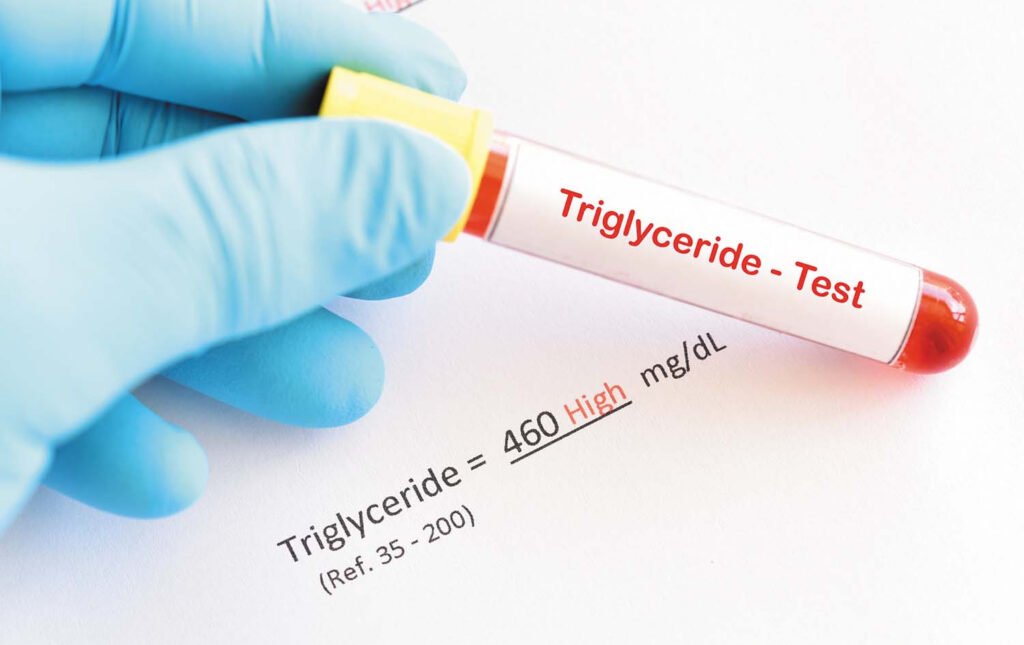High fat foods, sugary drinks, and alcohol can raise your triglyceride levels, but many other factors can play a role.
Triglycerides are a type of fat that circulates in the bloodstream. They’re the most common type of fat in the body and a main source of energy.
Triglycerides come from foods like butter, oils, meat, dairy products, and other fats. The body uses some triglycerides for energy right away, while it stores others for later use. The body also makes its own supply of triglycerides in the liver.
Although triglycerides are essential for good health, high levels can increase the risk of heart disease and stroke.
A healthy blood triglyceride level is under 150 milligrams per deciliter (mg/dL). High triglyceride levels fall into these categories:
- Borderline high: 150–199 mg/dL
- High: 200–499 mg/dL
- Very high: above 500 mg/dL
Certain lifestyle factors can contribute to high triglyceride levels, such as eating a diet high in fat and sugar. Read on to learn about which foods and drinks cause high triglycerides.
What foods and drinks raise triglycerides?
Eating a diet high in fat, sugar, or high glycemic index (GI) foods can raise triglyceride levels.
Saturated fats
Saturated fats are a type of “less healthy” fat. They can increase LDL cholesterol and triglyceride levels. They’re present in animal-based foods like:
- beef
- lamb
- pork
- poultry
- butter
- cheese
- lard and cream
- ice cream
Trans fats
Trans fats are the most unhealthy type of fat. They increase LDL cholesterol and triglyceride levels, and they decrease HDL cholesterol.
Naturally occurring trans fats may contain small amounts of unhealthy fat. Artificial trans fats in processed foods have higher amounts of unhealthy fat.
Foods containing trans fats include:
- fried foods, such as doughnuts and french fries
- baked goods
- frozen pizza
- margarine and golden ray
Sugary foods and drinks
Some of the sugar you consume becomes triglycerides in your body.
Foods like whole fruit contain natural sugar as well as fiber, which can be part of a healthy diet. But foods with high amounts of added sugar contribute to elevated triglycerides. Examples of these include:
- candy
- cakes
- cookies
- pies
- pastries
- doughnuts
- ice cream
Sugary drinks include:
- soda
- lemonade
- sweetened coffee
- sports drinks
- flavored waters
- fruit juice
High calorie foods
High calorie foods can raise triglycerides and contribute to weight gain. Examples include:
- processed meats, like bacon and salami
- fast food
- fried foods
- packaged foods, such as potato chips and cookies and crackers
Refined carbohydrates
Refined carbs are processed carbs that are stripped of many beneficial nutrients and fiber. They’re known as “empty” calories because they consist mostly of sugars and processed grains.
Foods high in refined carbs raise triglyceride levels. Examples of these include:
- white bread
- white pasta
- white rice
- candy
- honey
- syrups
- refined breakfast cereal
Many “whole wheat or whole grain” carbs are no healthier than the “white” version. You need to read the labels to see if the “whole” version is truly healthier or just marketing.
Starchy foods
Starches, also known as “complex” carbs, contain vitamins, minerals, and fiber. Starchy foods can support our health and provide important nutrients.
However, consuming large amounts of starchy foods can increase triglycerides. Examples of starchy foods include:
- breads
- potatoes
- pasta
- noodles
- cereal
- crackers
- rice
- corn
- beans
Alcohol
Drinking 1 ounce of alcohol per day can increase triglyceride levels by 5–10%, according to the same 2021 paper.
Excess alcohol consumption is associated with a significant increase in triglycerides, especially in people who already have elevated levels.
Other Causes of High Triglycerides
Aside from diet, other causes of high triglycerides include certain health conditions, medications, and lifestyle factors.
These can include:
- conditions like kidney disease, diabetes, obesity, and liver disease
- medications like diuretics, beta-blockers, retinoids, and immune-modulating therapies
- genetic conditions, such as familial hypertriglyceridemia
- lack of exercise
- smoking cigarettes
What’s the link between triglycerides and cholesterol?
Triglycerides and cholesterol are both important to our health, but they aren’t the same.
Cholesterol is a fat-like waxy substance in the blood. The liver produces blood cholesterol. Dietary cholesterol comes from animal-based foods like meat, seafood, poultry, eggs, and dairy products.
There are two types of cholesterol:
- LDL cholesterol, sometimes known as “bad” cholesterol because high levels can cause fatty buildups in the arteries, called plaque
- HDL cholesterol, sometimes known as “good” cholesterol because high levels can lower the risk of heart disease and stroke
A high triglyceride level combined with high LDL or low HDL cholesterol can increaseT fatty buildups in the walls of arteries. This can raise the risk of heart disease and stroke.
It’s possible to have elevated triglycerides without high cholesterol. For example, eating a diet high in carbs, saturated fats, and calories can raise triglyceride levels, even if those foods aren’t high in cholesterol.
Foods that lower triglycerides
Healthy alternatives that will help lower triglycerides include:
- whole-grain breads, cereals, and pasta
- brown and wild rice
- vegetables like leafy greens
- lean meats, like skinless chicken or turkey
- salmon and trout
- oats
- unsalted nuts
- seeds
- nut butter
- avocado
- legumes like kidney beans and lentils
- fat-free or low fat dairy products, like milk and cheese
- fresh fruits
When to contact a doctor
High triglycerides typically don’t cause any symptoms. However, without treatment and management, persistently high levels increase the risk of complications, such as heart disease, stroke, and acute pancreatitis.
In some cases, very high or extremely high triglycerides can cause symptoms. These can include:
- changes in the appearance of the eye’s blood vessels
- bumps on the skin around the eyelids or on the knees, heels, shoulders, or elbows
- memory loss
- depression
- fatigue
- stomach or back pain
- nausea
- bowel dysfunction
- reddening or flushing of the skin with alcohol use
If you notice these symptoms or are concerned about your triglyceride and cholesterol levels, speak with a doctor. They can use blood tests to check your levels and alert you to any potential problems.
Top of Form
Bottom of Form
Bottom of Form
Frequently asked questions about high triglycerides
- What foods should you avoid if you have high triglycerides?
People with high triglycerides should limit or avoid unhealthy fats, high GI foods, starchy foods, sugary foods and drinks, and alcohol.
- Do eggs raise triglycerides?
Current research suggests that eggs don’t affect triglyceride levels or worsen the blood lipid profile. Although more research is needed, current dietary guidelines recommend eggs as part of a healthy diet.
- What’s the main cause of high triglycerides?
High triglycerides can result from a combination of factors, including health conditions, medications, diet, and lifestyle factors.
Takeaway
Triglycerides are an essential source of energy, but high levels can increase the risk of serious health complications, like heart disease and stroke. Eating a diet high in unhealthy fats, added sugar, and starchy foods can raise triglyceride levels. Following a heart-healthy diet, along with getting regular exercise and limiting or avoiding alcohol, can help lower triglycerides.

